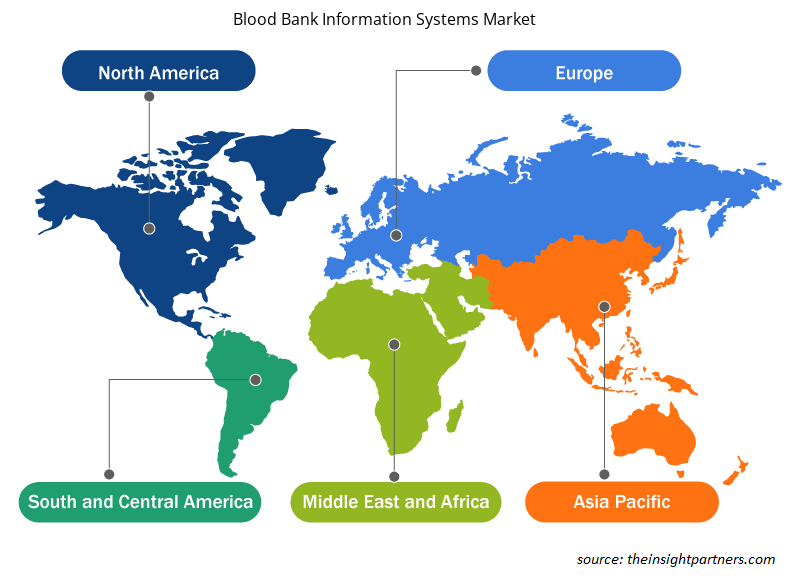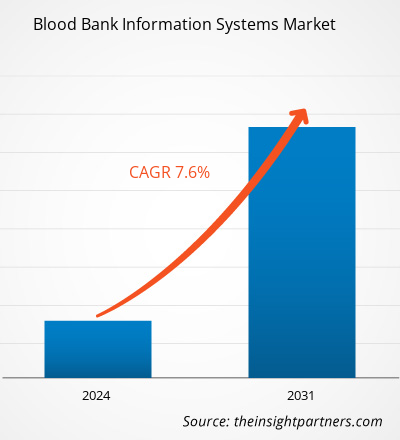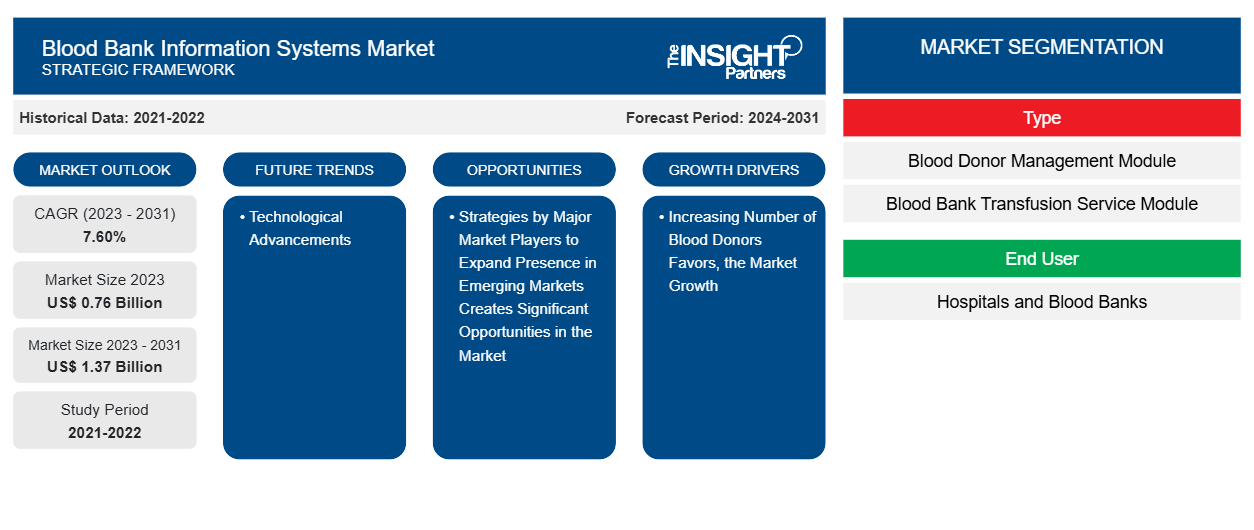血库信息系统市场规模预计将从 2023 年的 7.6 亿美元增至 2031 年的 13.7 亿美元。预计 2023-2031 年期间市场复合年增长率将达到7.60 %。技术进步很可能仍是市场的主要趋势。
血库信息系统市场分析
企业努力推出新产品,通过各种方式扩大业务应该会刺激市场。Cerner Corporation、Allscripts Healthcare, LLC、Haemonetics Corporation、WellSky、Hemosoft、Integrated Medical Systems、Soft Computer Consultants, Inc.、IT Synergistics、Psyche Systems Corporation 和Sunquest Information Systems, Inc. 等公司已经实施了各种战略,包括产品发布、产品批准、并购和市场计划。例如,CliniSys于 2022 年 1 月宣布,它最近收购了 HORIZON Lab Systems,并与Sunquest Information Systems合并成为CliniSys。
血库信息系统市场概览
全球血液病患病率的上升推动了对献血的需求。根据白血病和淋巴瘤协会 ( LLS ) 的数据,在美国,每三分钟就有一人被诊断出患有白血病、淋巴瘤或骨髓瘤。此外,2021 年,美国报告了约 186,400 例白血病、淋巴瘤和骨髓瘤病例。此外,2021 年,血癌病例约占美国估计的 1,898,160 例新发癌症病例的 9.8%。由于白血病等血癌发病率的上升,骨髓细胞移植和输血变得越来越普遍。美国红十字会估计,美国每天需要约 5,000 个血小板、6,500 个单位血浆和约 29,000 个单位红血球来治疗各种血液病。
此外,美国每年输血 1600 万份血液成分,用于治疗各种血液相关疾病,如血癌等。此外,据报道,2020 年,超过 180 万人被诊断出患有癌症。因此,由于血液病的增加,输血需求不断增加,推动了全球血库信息系统市场的增长。
定制此报告以满足您的需求
您可以免费定制任何报告,包括本报告的部分内容、国家级分析、Excel 数据包,以及为初创企业和大学提供优惠和折扣
-
获取此报告的关键市场趋势。这个免费样品将包括数据分析,从市场趋势到估计和预测。
血库信息系统市场驱动因素和机遇
献血者人数增加有利于市场增长
由于事故发生频率增加和血液病患病率不断上升,全球对血液的需求不断增长。世界卫生组织 (WHO) 估计,全球每年捐献血液约 1.184 亿单位。其中高收入国家收集了 40% 的血液。此外,分布在 169 个国家的约 13,300 个血库每年报告的捐献量为 1.06 亿。此外,根据 WHO 的数据,全球 33% 的献血者为女性。
此外,世卫组织报告称,2013 年至 2018 年间,156 个国家报告自愿无偿献血数量增加了 780 万。自愿无偿献血数量增幅最大的地区是非洲(23%)和美洲(25%)。西太平洋地区报告的绝对献血数量增幅最大(267 万),其次是美洲(266 万)和东南亚(237 万)。此外,自愿无偿献血占约 79 个国家血液供应量的 90% 以上,其中包括 38 个高收入国家、33 个中等收入国家和 8 个低收入国家。此外,62 个国家的血液供应来自自愿无偿献血者。
此外,全球超过一半的血液供应(56 个国家、9 个高收入国家、37 个中等收入国家和 10 个低收入国家)依赖有偿献血和家庭献血。这增加了全球对血库信息系统的需求。随着全球献血者的增加,血库以新颖和创新的方式管理和储存血液。血库信息系统主要用于收集献血。例如,2020 年,Samson Oloruntoba和其他出版商发表了一份关于开发血液检索系统的报告,以帮助管理献血者记录并规范政府医院的血液分配。该系统可以及时、高效和保密的方式快速访问献血者记录的医疗报告。它的基础是一个基于 Android 和 Web 的献血库存系统,强调降低输血错误。这些要素支持血库信息系统的市场扩张。
主要市场参与者扩大新兴市场影响力的战略为市场创造了重大机遇
由于亚太地区和中南美洲的献血者数量不断增加,血库信息系统市场参与者计划在多个领域发展。通过采用传统的献血者管理系统和血库输血服务模块,深度学习在血液管理方面表现出色。最近,血库信息系统引起了广泛研究关注。在未来几年,预计包括WellSky、Sunset Information Systems、SCC Soft Computer 的血库和Allscripts Healthcare Solutions 在内的众多企业将通过合并、收购和战略联盟继续在这些发展中市场扩张。2018 年 6 月,科罗拉多州最好的儿科医院之一使用WellSky 的 Mediware软件进行血液管理服务。该软件提供工具来支持保证儿童获得所需各种血液制品的程序。医院实施了Mediware的三种血液管理解决方案——HCLL 、LifeTrak和Trastem——来处理血液供应链。 Psyche Systems Corporation、Cerner Corporation、Haemonetics Corporation、Hemosoft等公司多年来已建立了服务产品,表明了它们在该地区的战略定位。在整个预测期内,这些市场机会将支持血库信息系统的扩展。
血库信息系统市场报告细分分析
有助于得出血库信息系统市场分析的关键部分是类型和最终用户。
- 根据类型,血库信息系统市场分为献血者管理模块、血库输血服务模块等。献血者管理模块部分在 2023 年占据了最大的市场份额。
- 根据最终用户,市场分为医院和血库。2023 年,医院部分占据了相当大的市场份额。
血库信息系统市场份额(按地区)分析
血库信息系统市场报告的地理范围主要分为五个区域:北美、亚太、欧洲、中东和非洲、南美和中美。
北美血库信息系统市场分为美国、加拿大和墨西哥。北美在全球血库信息系统市场中占据主导地位,预计这一趋势将在预测期内持续下去。预计北美将在预测期内占据最大的市场份额。这是由于对安全输血的需求不断增加,以及该地区医院和血库数量的不断增加。公众对献血重要性的认识不断提高也促进了这一扩张。由于美国拥有多元化的血液采集系统,因此没有关于采集的血液单位数或生产或输血成分的中央数据存储库。美国红十字会 (ARC) 收集了美国每年 1400 万单位全血中的约 45%。其他社区血库收集约 42%,医院收集约 11%,其余 2% 为进口。医院血库必须拥有基于计算机的信息系统才能满足要求。该系统简化了血库管理,并确保了血液和血液成分储存、分配和可追溯性的安全性。它可以为每个输血病人创建一个医疗档案,其中包含输血成分的特征以及病人的免疫药理学状态,这些信息是通过电子数据交换从血液机构接收的。
血库信息系统市场区域洞察
Insight Partners 的分析师已详细解释了预测期内影响血库信息系统市场的区域趋势和因素。本节还讨论了北美、欧洲、亚太地区、中东和非洲以及南美和中美洲的血库信息系统市场细分和地理位置。

- 获取血库信息系统市场的区域特定数据
血库信息系统市场报告范围
| 报告属性 | 细节 |
|---|---|
| 2023 年的市场规模 | 7.6亿美元 |
| 2031 年市场规模 | 13.7亿美元 |
| 全球复合年增长率(2023 - 2031) | 7.60% |
| 史料 | 2021-2022 |
| 预测期 | 2024-2031 |
| 涵盖的领域 |
按类型
|
| 覆盖地区和国家 |
北美
|
| 市场领导者和主要公司简介 |
|
血库信息系统市场参与者密度:了解其对业务动态的影响
血库信息系统市场正在快速增长,这得益于终端用户需求的不断增长,而这些需求又源于消费者偏好的不断变化、技术进步以及对产品优势的认识不断提高等因素。随着需求的增加,企业正在扩大其产品范围,进行创新以满足消费者的需求,并利用新兴趋势,从而进一步推动市场增长。
市场参与者密度是指在特定市场或行业内运营的企业或公司的分布情况。它表明在给定市场空间中,相对于其规模或总市场价值,有多少竞争对手(市场参与者)存在。
在血库信息系统市场运营的主要公司有:
- 血液软化剂
- Cerner 公司
- Allscripts Healthcare, LLC
- 血液透析公司
- 综合医疗系统
- 软计算机顾问有限公司
免责声明:上面列出的公司没有按照任何特定顺序排列。

- 获取血库信息系统市场顶级关键参与者概述
血库信息系统市场新闻和最新发展
血库信息系统市场通过收集一级和二级研究后的定性和定量数据进行评估,其中包括重要的公司出版物、协会数据和数据库。血库信息系统市场的一些发展如下:
- 血液管理系统领域的全球领导者 MAK-System 自豪地宣布与纽约血液中心企业 (NYBCe) 建立长期战略合作伙伴关系。根据协议,MAK-System 将以托管服务的形式运营 MAK.care 平台,代表 NYBCe 运营整个数字生态系统。这项为期 10 年的协议将利用托管服务的优势,改变血液的管理和输送方式。(来源:MAK-System,新闻稿,2023 年 6 月)
- CliniSys 宣布最近收购了 HORIZON Lab Systems,并与 Sunquest Information Systems 合并为 CliniSys。此次收购和 Sunquest 合并创建了世界上最大的诊断和实验室信息学组织之一。(来源:Sunquest Information Systems, Inc.,新闻稿,2022 年 1 月)
血库信息系统市场报告范围和交付成果
“血库信息系统市场规模和预测(2021-2031)”报告对以下领域进行了详细的市场分析:
- 血库信息系统市场规模及全球、区域和国家层面所有主要细分市场的预测
- 血库信息系统市场趋势以及市场动态,如驱动因素、限制因素和关键机遇
- 详细的 PEST/波特五力分析和 SWOT 分析
- 血库信息系统市场分析涵盖主要市场趋势、全球和区域框架、主要参与者、法规和最新的市场发展。
- 行业格局和竞争分析,涵盖市场集中度、热图分析、知名参与者以及血库信息系统市场的最新发展
- 详细的公司简介
- 历史分析(2 年)、基准年、预测(7 年)及复合年增长率
- PEST和SWOT分析
- 市场规模、价值/数量 - 全球、区域、国家
- 行业和竞争格局
- Excel 数据集
近期报告
相关报告
客户评价
购买理由
- 明智的决策
- 了解市场动态
- 竞争分析
- 客户洞察
- 市场预测
- 风险规避
- 战略规划
- 投资论证
- 识别新兴市场
- 优化营销策略
- 提升运营效率
- 顺应监管趋势























 获取免费样品 - 血库信息系统市场
获取免费样品 - 血库信息系统市场